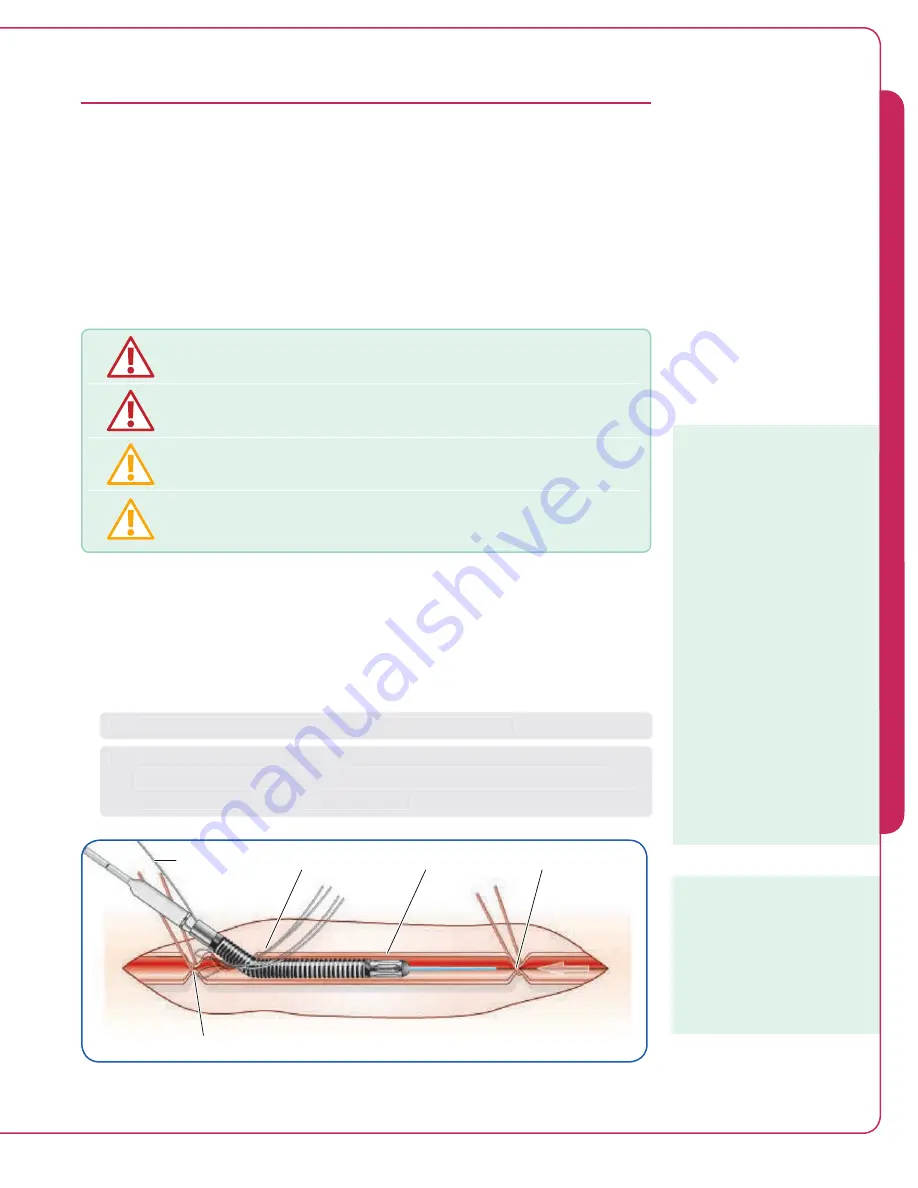
5.25
Impella
®
System for Use During Cardiogenic Shock
ALTERNATE INSERTION TECHNIQUE FOR THE IMPELLA
®
5.0 CATHETER
NOTE – Proper surgical procedures and techniques are the responsibility of
the medical professional. The described procedure is furnished for information
purposes only. Each physician must evaluate the appropriateness of the procedure
based on his or her medical training and experience, the type of procedure, and
the type of systems used.
Fluoroscopy is required to guide placement of the Impella
®
5.0 Catheter. The small
placement guidewire must be reliably observed at all times.
Avoid manual compression of the inlet, outlet, or sensor areas of the cannula
assembly.
Do
NOT
kink or clamp the Impella
®
Catheter with anything other than a soft jaw
vascular clamp. Do
NOT
kink or clamp the peel-away introducer.
Handle with care. The Impella
®
5.0 Catheter can be damaged during removal from
packaging, preparation, insertion, and removal. Do
NOT
bend, pull, or place excess
pressure on the catheter or mechanical components at any time.
This section describes two alternative techniques for insertion of the Impella
®
5.0 Catheter:
• Femoral insertion
• Femoral insertion with sidearm graft
TECHNIQUE FOR FEMORAL ARTERY INSERTION
1.
Identify the femoral artery and perform a cut-down of 3 to 5 cm.
2.
Expose the femoral artery. Wrap vessel loops, one distal and one proximal to the
subsequent point of incision, one and a half times around the artery. Make the vessel
loops as far apart as possible (see Figure 5.30).
Distal Vessel Loop
Guidewire
U-Stitches
Femoral Artery
Proximal Vessel Loop
Figure 5.30 Cut-Down Insertion of the Impella
®
5.0 Catheter
Use Fluoroscopy for
Placement
Impella
®
5.0 Catheter
performance will be
compromised if correct
placement cannot be
confirmed. While other
imaging techniques,
such as transesophageal
echocardiography (TEE), can
help confirm the position of
the Impella
®
5.0 Catheter
after placement, TEE does
not allow visualization of
the entire catheter assembly
and is inadequate for reliably
placing the Impella
®
5.0
Catheter across the aortic
valve.
1.
1.
Identify the femoral artery and perform a cut-down of 3 to 5 cm.
2.
2.
Expose the femoral artery. Wrap vessel loops, one distal and one proximal to the
subsequent point of incision, one and a half times around the artery. Make the vessel
loops as far apart as possible (see Figure 5.30).
Keep ACT ≥ 250 Seconds
Maintaining ACT at or above
250 seconds will help prevent
a thrombus from entering
the catheter and causing a
sudden stop on startup.
5
U
S
IN
G
T
H
E A
U
TO
MA
TED
I
M
P
EL
LA
®
C
O
NT
R
O
LL
E
R
WI
TH
TH
E I
M
P
E
LL
A
®
C
A
TH
ETE
R
Содержание Impella 2.5
Страница 4: ......
Страница 8: ......
Страница 10: ......
Страница 12: ......
Страница 15: ...2 WARNINGS AND CAUTIONS WARNINGS 2 1 CAUTIONS 2 3...
Страница 16: ......
Страница 22: ......
Страница 38: ......
Страница 40: ......
Страница 108: ......
Страница 171: ......
Страница 173: ......
Страница 181: ......
Страница 183: ......
Страница 201: ......
Страница 203: ......
Страница 205: ......
Страница 210: ...INDEX TBD...
















































